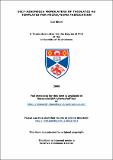Files in this item
Self-assembled monolayers of thiolates as templates for micro/nano fabrication
Item metadata
| dc.contributor.advisor | Buck, Manfred | |
| dc.contributor.author | Shen, Cai | |
| dc.coverage.spatial | 176 | en |
| dc.date.accessioned | 2008-12-18T10:08:52Z | |
| dc.date.available | 2008-12-18T10:08:52Z | |
| dc.date.issued | 2008-10-08 | |
| dc.identifier | uk.bl.ethos.552199 | |
| dc.identifier.uri | https://hdl.handle.net/10023/603 | |
| dc.description.abstract | Self-assembled monolayers (SAMs) were investigated with regard to their application as templates to control processes down to the nanometre length scale. With applications of SAM for electrochemical nanotechnology in mind, the range of aspects studied comprises patterning on different length scales, behaviour of SAMs under the conditions of electrochemical metal deposition, and the influence of the head and tail groups on formation and structure of SAMs. On a micrometre scale, laser scanning lithography (LSL) was used to pattern SAM covered Au surfaces. With this technique, localized regions of a SAM are desorbed by scanning the focal spot of a laser beam. Thermal desorption occurs as a result of the high substrate temperature produced by the laser pulses. Patterns with line width as small as 0.9 µm were produced by LSL. It is demonstrated that SAM can not only be patterned by laser radiation but can also be rendered more passive as revealed by electrochemical metal deposition. Such blocking effect is explained by annealing of defects upon irradiation at the appropriate laser energy. This effect can block deposition of bulk copper particles, but does not prevent the underpotential deposition. Based on this passivation effect, large passivation areas can be created, which can be used as substrate for further nano/micro fabrication. The combination of SAM patterning and electrochemical metal deposition was also demonstrated to be an effective way to prepare superhydrophobic surfaces, exhibiting a contact angle of 165° (water droplet). Aiming for the generation of smaller structures, scanning tunneling microscopy (STM) is used as a tool to pattern SAMs. Several phenomena observed in STM based manipulation of SAMs are addressed. The first one is sweeping effect. Deposited metal particles on top of SAM and SAMs are swept by STM tip by choosing appropriate I/V parameters. The closer the tip (higher current, lower bias), the more effective it is. Molecularly resolved images confirm that after sweeping, the scanned area is still covered by SAM molecules. This is explained by diffusion. The sweeping process can be repeated, thus, resulting in a layer by layer etching. The second effect is field-induced desorption. Applying a positive voltage (2.5-5V), a SAM is damaged beneath the area of the tip. The damage depends not only on the bias applied, but also on the current setpoint right before applying the bias. The third effect is nanografting. Nanografting was observed that a SAM having a stronger assembling ability can replace the weaker one (matrix layer) in hexadecane solution by STM scanning under normal I/V parameters combination that are usually used for imaging. It is found that longer chain can replace the shorter chain thiol, alkanethiol can replace biphenyl thiol. This method can be applied to pattern SAM. Defects (punched holes) were created purposely on the SAMs covered Au surface and in situ STM was used to investigate the process of Under-Potential Deposition (UPD) and bulk metal deposition. Bulk metal deposition on punched holes depends on the size. Small scale patterning by punching is sufficient for applications based on UPD but not for bulk metal deposition. Several SAMs assembled on Au(111) surface (1-mercaptoundecanoic acid (MUA), Dodecyl Thiocyanate (C12SCN) and bis(pyrazol-1-yl)pyridine-substituted thiol (bpp-SH) and thiocyanate (bpp-SCN)) were investigated with the aim to expand the type of SAMs that can be used as template for further application, such as metal coordination. High quality thiolate monolayers formed by cleavage of the S-CN bond can be obtained on Au(111). Thus, organothiocyanates appear to be a promising alternative to thiols. Well-ordered MUA monolayers are formed in a few hours at the temperature range of 323-363 K by Physical Vapour Deposition (PVD). Self-assembled monolayers of bpp-SH and bpp-SCN on Au(111)/mica were studied with STM. Preparation conditions such as temperature, solvent, and contamination affect the formation of SAMs on Au(111) much more than other common thiols such as alkanethiols and biphenythiols. | en |
| dc.format.extent | 2675 bytes | |
| dc.format.mimetype | application/pdf | |
| dc.language.iso | en | en |
| dc.publisher | University of St Andrews | |
| dc.rights | Creative Commons Attribution-NonCommercial-NoDerivs 3.0 Unported | |
| dc.rights.uri | http://creativecommons.org/licenses/by-nc-nd/3.0/ | |
| dc.subject | Self-assembled monolayers | en |
| dc.subject | Electrochemical nanotechnology | en |
| dc.title | Self-assembled monolayers of thiolates as templates for micro/nano fabrication | en |
| dc.type | Thesis | en |
| dc.type.qualificationlevel | Doctoral | en |
| dc.type.qualificationname | PhD Doctor of Philosophy | en |
| dc.publisher.institution | The University of St Andrews | en |
This item appears in the following Collection(s)
Except where otherwise noted within the work, this item's licence for re-use is described as Creative Commons Attribution-NonCommercial-NoDerivs 3.0 Unported
Items in the St Andrews Research Repository are protected by copyright, with all rights reserved, unless otherwise indicated.


